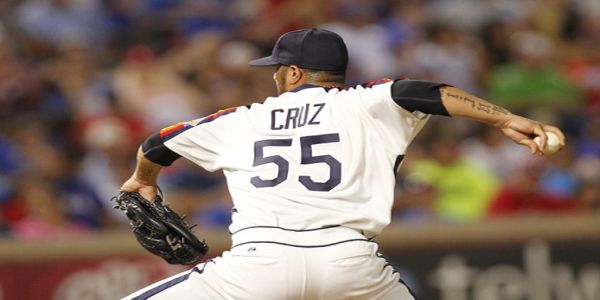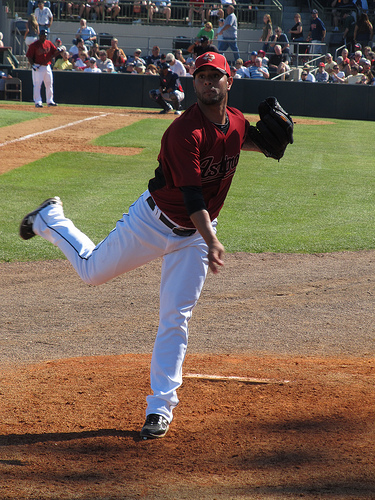Deeper League Relief Finds for Fantasy Baseball, American League


For players in deeper leagues that find it useful to have a reliever with 70+ K upside or a real outside shot at saves, the below represent some of the best options out there.
Rhiner Cruz, Houston Astros: To say the Astros’ pen is light on potential is an understatement. There is enough with Jose Veras to see him being a solid or even above average reliever. However, once he shows this ability, he’ll be on the trading block quickly. Some foresee the emergence of Sam Demel, but they might be off target in their dark horse saves candidate. Instead, folks should look and remember the name Rhiner Cruz (who was the first overall selection in the 2011 Rule-5 draft).
Since he was required to be with the big league club, Cruz provided some innings for the ‘Stros last season – they were mostly awful though. Still, Cruz is just 26 and posted some real nice K% in the lower minors with the Mets. However, he really had trouble finding the strike zone. While his failure to find the zone continued at the MLB level with an 11.5 BB%, he did have a decent first strike rate (60.9%) and fooled some batters (10.6% swinging strike rate). It didn’t translate to many K’s (18.2 K%), but it could down the road (he does have a mid-90s heater).
- Since 2010, 86 qualified relievers have at least a 10% swinging strike rate—only nine of those pitchers had a K% lower than 20.3%. In fact, this group averaged a 9.5 K/9 rate.
- Of the 86 RPs, 56 posted a first-strike rate above 60%, with just 19 of those posting a K% lower than 20.3%. This group averaged an 8.3 K/9 rate.
- Lastly, of the 86 RPs, only 26 had a first-strike rate over 60% and swinging strike rate better than 10%–making Cruz somewhat unique. If Cruz can continue to get ahead of hitters and cause some swings and misses, there’s a solid chance he evolves into a K-per-inning type reliever.
Kelvin Herrera, Kansas City Royals: There are certainly some solid relievers in front of Herrera, however not a single one is perfect. Greg Holland should provide a lot of K’s, but he does walk a ton of batters. Aaron Crow has a harder time throwing strikes and likely isn’t the strike-out artist Holland is. Tim Collins brings it, but is a lefty and has always walked a ton of batters (last season his first-strike rate regressed). Enter Herrera who threw 84 innings in relief for the Royals last season. His BB% (6.1%) was impeccable, echoing his solid rates at AA and the lower minors. He didn’t post an overwhelming K rate, but it was solid and supported by an average first-strike rate and 11.1 swinging strike percentage. While his ERA last season was a bit buoyed by an 80.9% strand rate, his devastating change (for video see: this) helped result in the 18th highest ground ball rate. He doesn’t flash the strike-outs you normally see in a closer; however, with his solid GB rate and ability to throw strikes, he provides a stability that isn’t exactly present throughout the Royals’ pen.
Carter Capps, Seattle Mariners: Last year, Capps threw 75 innings across AA, AAA (just 1.1) and the MLB level and looked good: his worst K% (25.7%) and BB% (10.1%) were both at the MLB level. Capps averaged 98 MPHs on his fastball in the majors and is ready to contribute now. He doesn’t have or use secondary pitches much, which could limit his upside, but a 3.80 ERA, 1.35 WHIP and 80 K’s seem reasonable – and there is some upside on those numbers. He isn’t on a ton of radars, but 80 K’s for $1 or at the end of your draft is incredibly valuable. In addition, there aren’t a lot of battle tested arms in front of him. Tom Wilhelmsen came out of nowhere to somehow provide his best season ever in the majors (he couldn’t fool AA hitters but mesmerized MLB batters). Meanwhile Shawn Kelley and Charlie Furbush are just decent relievers. Suddenly, you wouldn’t be so shocked if you get 30 saves and 80 K’s from Capps, eh?
Esmil Rogers, Toronto Blue Jays: Rogers, to date, seems a bit uninspiring: a 19.5 K% and 9.5 BB% to his name. However, a lot of that was from starting and pitching in Colorado. As a reliever, Rogers has a 23.1 K% and 9.3 BB%. Last season, the first during which he was a full time reliever, he threw his fourseamer more and added one MPH of velocity (bringing it to 96). He also threw his slider more and packed on a bit of velocity. The Jays have a somewhat crowded pen, but there are questions. Sergio Santos is battling back from an injury and wildness and Casey Janssen doesn’t really profile as a closer and has some pesky injury troubles as well. Darren Oliver and Aaron Loup are around, but likely will fit somewhat traditional LOOGY roles. Then there is Steve Delabar who will strike out a ton of guys, but walk a lot and Brad Lincoln who should be solid but just not interesting. Meanwhile, Rogers could end up being one of the better relievers in the Blue Jays pen: 70 innings, 3.75 ERA, 1.35 WHIP and 70 K’s. The Jays will have a tremendous amount of pressure on them – if a closer or high-leverage reliever falters, Rogers should find his way to holds or even saves.
Junichi Tazawa, Boston Red Sox: There are legitimate concerns of Joel Hanrahan breaking down or losing something in the move from Pittsburgh to Boston. In addition, Andrew Bailey hasn’t been healthy lately and there have been whispers of the Red Sox trying to move him. This provides ample opportunity for Tazawa to take over a high leverage role for the Sox. From August 1 through the end of the season, Tazawa appeared in 27 games and batters hit .215/.241/.308 off him. He showed remarkable command, walking just four batters against 32 K’s. That (and his entire MLB career) is a pretty small sample spread across a few too many years to draw much from. However, he does have 208 minor league innings (albeit mostly as a starter) with a 3.11 ERA, 1.13 WHIP and 3.48 K:BB rate. At AAA (68 IPs), Tazawa has posted a 2.51 ERA, 1.12 WHIP and 3.86 K:BB rate. Tazawa appears fully recovered from Tommy John surgery and would be a cagey bet to throw the best innings in Boston’s revamped bullpen this season: 70 K’s, 2.80 ERA and 1.18 WHIP. Whether he ends up with a ton of holds or saves depends on Hanrahan and Bailey.
Jake McGee, Tampa Bay Rays: The likelihood McGee gets more than five saves is small – the Rays know that saves are the way to pump up arbitration dollars and keeping McGee in a different role will help them save money. While he is a lefty, McGee dominates righties just as much and might even fair a bit better in reverse platoon situations. With Wade Davis out of the picture, McGee should be able to come close to 70 innings, which would be 70 K’s and impeccable ratios. In holds or rates leagues, McGee would be one of the more valuable relievers.
Tommy Hunter, Baltimore Orioles: By most reasonable counts, Hunter isn’t one of the top eight starters on Baltimore’s depth chart at the moment. Add that and his late-season relief work and there’s a solid chance Hunter is a reliever for the majority of 2013. That said, Hunter has just 34 relief innings to his name, so it’s hard to parse exactly what kind of a reliever he can be. But, in those outings, he has posted a far better K:BB rate than as a starter. Last year, as a reliever, he posted a 21.1 K% and just 5.3 BB%. In September of last season, when he threw 12.2 IPs in relief, Hunter had a 17.19% swing/whiff rate on his fourseam with a 33.33% rate on his cutter. For his career, he has an 11.7% rate on his fourseam and 14.2% on his cutter. And, in September, he averaged 97 MPHs on the fourseam, 96 MPHs on his sinker and 92.7 MPHs on his cutter. Those numbers are all significantly higher than his career totals. Hunter, the reliever, could be a surprisingly valuable asset in real and fake baseball. If he is a reliever full time, look for 70-80 IPs, 63+ K’s (upside to 80) and a good amount of holds.
In addition, you get the sense that Buck Showalter likes to use Darren O’Day as a high leverage reliever throughout a game (he is least likely to walk a batter with the bases loaded). With Pedro Strop struggling last season, if something happens to Jim Johnson, Hunter could be the first reliever tabbed as closer.
Cory Burns, Texas Rangers: Burns hasn’t been given much opportunity at the major league level, despite routinely dominating the minors. He doesn’t have much of a fastball, but his change-up is top notch. He also is capable of getting a decent amount of ground balls, which should help in the Texas sun. It’s not entirely clear whether his repertoire will translate to the major league level, but there’s certainly a chance. There aren’t a ton of healthy, reliable relievers in the Rangers’ pen at the moment which will give Burns every opportunity to stick.






2 Comments
[…] Read the full article at The Fantasy Fix: https://thefantasyfix.com/2013/01/deeper-league-relief-finds-for-fantasy-baseball-american-league/ […]
[…] cliff notes, check out here and here, which focused on some sleeper candidates including Rhiner Cruz, Kelvin Herrera, […]